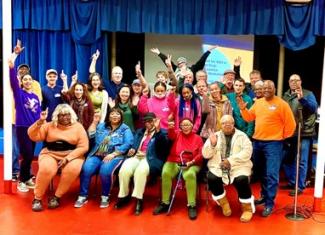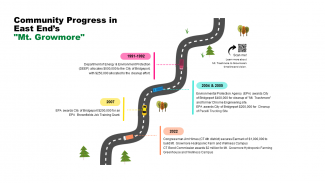For decades, the East End neighborhood of Bridgeport, Connecticut, has faced the environmental, health and economic ordeal of Mount Trashmore, a three-story abandoned waste dump. In the 1990s, local community members’ advocacy helped clean up the site. Unfortunately, remediation was incomplete. The site became a magnet for illegal dumping, health hazards, disinvestment, and crime. Yet the surrounding community of color, which was facing poverty, pollution, disease, and violence, sought to revitalize Mount Trashmore with an unyielding spirit for the benefit of their children and families.
Two decades later, Mount Trashmore is transforming into Mount Growmore, a hydroponic farm, wellness campus, and learning center. The project is a collaborative effort led by the East End Neighborhood Revitalization Zone (NRZ) and East End NRZ Fresh Food Market, and supported by the Elevate Policy Lab of the Child Study Center, Yale School of Medicine, along with government at all levels. Through continued remediation and revitalization, Mount will also serve as a national model for realizing community-driven environmental justice and health equity.
How East End Made It Happen

On top of vigorous community support, the success of Mount Growmore is driven by the community’s application of Triple Bottom Line Justice (TBLJ), a framework spearheaded by the Yale Elevate Policy Lab. TBLJ seeks to realize health, environmental, and economic justice by addressing adverse social determinants and root causes of health disparities. TBLJ’s two main tools, Brownfields to Healthfields (B2H) and Civic Justice Engagement Teaching (CJET), are discussed below.
B2H is a community-created, multi-stakeholder, collaborative, and inclusive approach that transforms brownfields into areas that strengthen community health, equity, sustainability, and resilience. It improves family mental health by addressing environmental adversity and basic needs like health care, nutritious food, and physical activity. A significant component of B2H is “Breaking Bread,” the act of convening to build trust, strengthen relationships, and foster shared learning and replication of successful strategies. This convening brings diverse parties, resources, and information together to organize and maintain the B2H process. For Mount Growmore, Breaking Bread brought together community leaders (East End NRZ Market & Café), the state government (Connecticut Department of Energy & Environmental Protection), the federal government (U.S. Environmental Protection Agency), and academia (Yale Elevate Policy Lab, Environmental Protection Clinic, and the Child Study Center Children and Adolescent Psychiatry Fellowship). The effective use of the TBLJ framework for Mt. Growmore represents the next generation of B2H because it confronts environmental stressors to mental health, supports access to basic needs and safety, and advances economic and social mobility. It is a gamechanger for brownfields redevelopment.
Yale Elevate Policy Lab and the East End NRZ Market and Café developed Civic Justice Engagement Teaching (CJET), the second TBLJ approach, to strengthen meaningful engagement with environmental, health and economic justice through rule of law. CJET utilizes an integrated policy and place-based practices approach to promote family mental health, disrupt poverty, foster economic mobility, and advance environmental resiliency. In practice, CJET implements these strategies in several ways. CJET provides educational information and group activities related to rule of law, especially environmental law. It strengthens the capacity of community members—lived experience experts—to address their concerns by increasing awareness of legal avenues to remedy environmental adversity and stressors, which hinder family mental health, economic standing, resilience, and social mobility. CJET also facilitates engagement with government officials who can support the community to resolve environmental and health challenges through technical assistance and funding. Together, the effort helps the community overcome burdens that impact how they live, learn, work, play, develop, and worship and affect a wide range of health, functioning, and quality-of-life outcomes.
The Future of Mount Growmore

To “grow healthy food and healthy people” and serve as a national model, Mount Growmore is developing the next generation of TBLJ. For example, Mount Growmore’s wellness campus is will be tailored to meet the mental health needs of East End’s children, caregivers, and families. By addressing environmental stressors such as brownfields, Mount Growmore can help limit dangerous activities related to drug and youth violence while facilitating access to services for children and families impacted by acute and chronic mental health challenges. Further, the Environmental Protection Clinic at the Yale Law School is collaborating to help build out the new model of environmental justice practice grounded in civic engagement methods. Using an interdisciplinary approach, the law clinic brings together students from the Law School, the School of the Environment, and the School of Public Health to holistically address community identified challenges.
Bringing Brownfield Revitalization to Your Community
Understanding where to start with brownfields revitalization can be confusing and unclear. Despite this, there are several instructional resources for action that detail how communities can understand, finance, and organize brownfields redevelopment. Listed below are a variety of resources to help get the ball rolling in your community.
What do I have to do to start this in my community?
- EPA’s Anatomy of Brownfields Redevelopment Guide offers an outline of how to bring brownfields clean up to your community, including an in-depth overview of the process, questions you should consider, and management arrangements necessary for brownfields redevelopment.
- EPA’s Cleaning Up Brownfields Under State Response Programs Guide outlines the requirements and process for entering your state’s brownfields program.
- The Journal of the American Institute of Architects offers a plainly worded technical overview of the brownfields clean-up process.
Where can my community find support?
- EPA offers localized support in the form of technical assistance, guides, application instructions, and grant resources based on location (aligning with support offered by state governments).
- EPA’s brownfields assistance menu provides a condensed list of grant, technical assistance, and capacity building resource examples.
- The Bipartisan Infrastructure Law, passed last year, will bolster a number of EPA funding channels for brownfields, including programs utilized for Mount Growmore’s revitalization.
- Yale’s Elevate Policy Lab convenes communities, policy experts, and practitioners on advancing family mental health and eliminating poverty. See their Brownfields to Healthfields and Family Mental Health Fact Sheet (link on blog). Learn more about their civic justice engagement and leadership initiatives.
- The state of Connecticut offers state-specific environmental justice and brownfields programs’ resources, guidelines, requirements, and opportunities.
How can I account for community health and equity?
- Elevate Policy Lab’s Blueprint for Action to Advance Family Mental Health with Triple Bottom Line Justice offers important considerations for reaching Bottom Triple Line Justice.
- EPA’s overview of brownfields and public health highlights connections between brownfields and community health.
- EPA’s opportunities for environmental justice communities outlines federal resources available for environmental justice communities and who qualifies.
- EPA Region One’s equitable development for brownfields document offers important considerations and takeaways on how to engage and benefit underprivileged communities rather than reproduce generational harms.
Where can I find more information about what brownfield revitalization looks like in practice at Mount Growmore?
- See the Connecticut Post’s article on Mount Trashmore’s green transformation.
- Visit the East End NRZ Market and Café’s website for examples of Mount Growmore’s successes and present status.
- See the East End NRZ Market and Café’s overview of progress fact sheet for more information about Mount Growmore’s timeline, challenges, and solutions that might be applicable to your community!
This post was created in conjunction with the Mount Trashmore to Mount Growmore People, Places, and Planet Podcast. Listen to the episode here.

